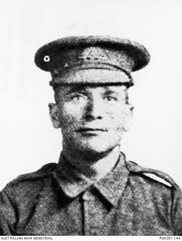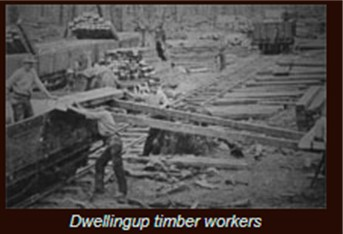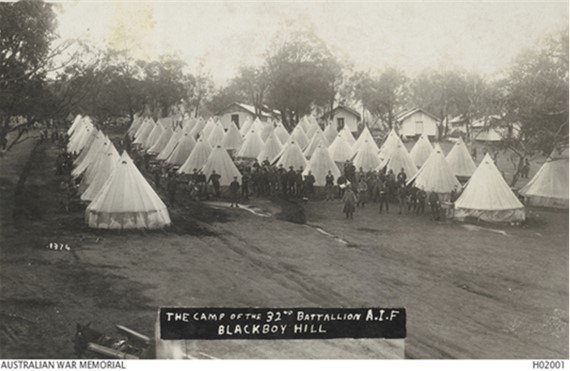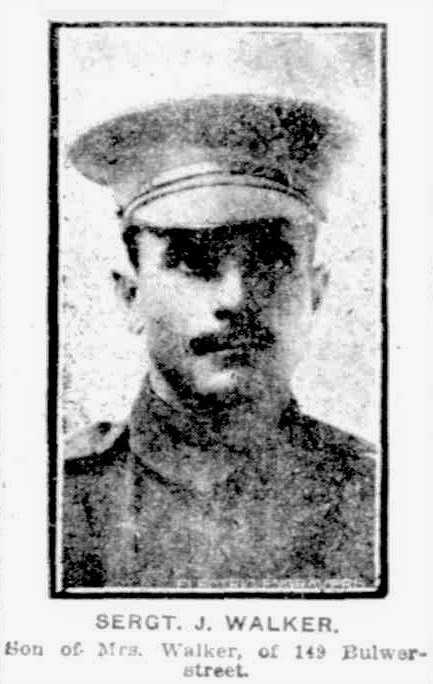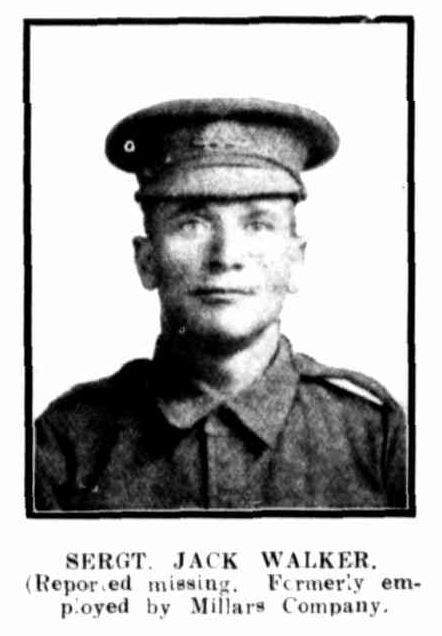John Michael WALKER
Eyes grey, Hair brown, Complexion sallow
Walker Family Background
John Michael Bowen Walker was the youngest of six children (two died in infancy) and was born in 1884 in Mooroopna, near Shepparton in northern Victoria. His parents, William and Anne (nee Bowen), came from families that had migrated to Australia from Scotland and Ireland in the mid-1800’s.
Originally from Melbourne, the family moved to Mooroopna around 1880 as the area was rapidly expanding when the railroad came through. John’s education was in the Victorian State Schools.
By the early 1900’s, the family had moved to Western Australia presumably following the work in timber and railways that was available in Perth in the post-1890’s gold rush prosperity. John, his father William, and his brother Rodney all worked for Millars’ Timber and Trading Company, a well-known firm in Perth. John worked as a clerk/timekeeper, his older brother Rodney was a manager and their father William was a timber inspector. By 1915, John was working in the sawmill in small town of Dwellingup, about 100 kilometres south of Perth.
Off to War
By mid-1915, recruiting for the War was high. Folks in WA were keen to support the effort with a third of all men in the state aged 18 to 41 joining up between 1914-1918. John Walker was no exception.
John enlisted on 3 June 1915, aged 30, but subtracted a year from his age on his enlistment papers. He was assigned to D Company, 32nd Battalion and sent to training camp at Blackboy Hill, about 70 kilometres from Dwellingup.
The soldiers’ initial training continued until the end of August, at which time John was promoted to Sergeant.
In late August, C and D companies departed Western Australia to join the A and B Companies that had been formed in Adelaide. Further training continued and the full Battalion left Australia aboard HMAT Geelong on 18 November 1915, bound for Egypt. As reported in The Adelaide Register:
“The 32nd Battalion went away with the determination to uphold the newborn prestige of Australian troops, and they were accorded a farewell which reflected the assurance of South Australians that that resolve would be realized.”
They arrived in Suez on 18 December and their training continued in El Ferdan, Ismalia, Tel-el-Kebir, Ferry Post, Duntroon Plateau and Moascar. During their time in Egypt, they were inspected by H.R.H Prince of Wales.
The Western Front
In mid-June, the call came to support the Western Front and the 32nd embarked from Alexandria aboard the ship ‘Transylvania’ on 17 June 1916. They arrived at Marseilles to join the British Expeditionary Force in France on 23 June 1916.
They departed Marseilles by train for the two-day trip to Hazebrouck, about 30 kilometres from Fleurbaix. In a letter home that was published in WA papers, Sergeant Walker briefly described their boat trip from Egypt and then went on to tell of their trip through France to the front:
"Arrived in France. Writing this in train now. ……….. No wonder the Frenchman loves his country. I cannot describe it, but it is the finest place I have ever seen. All along the line is dense foliage. Nice cottages on small farms; bit of crop, bit of vineyard, everything, in fact. Lots of fruit, but we are not al-lowed to take or buy any fruit, only what the French people care to give us.
……….It's funny to see the women working in the fields; they and the old men appear to do all the work. Seems as if all the men are away at the front, but the women and children cheer and wave to us as we go through. Have done now 300 miles. Have to do between 700 and 800. It has been like passing through a garden -wild roses, creepers and poppies all the way. In charge of Railway stations are women. Lots of men under them, and they do the work well.
I have been 30 hours in the train. Saw an airship this morning; just like a big sausage suspended in the air. Saw one of the funniest things I ever witnessed. We had pulled up at a very busy station. The stationmaster was spitting out orders and rousing them up when our band struck up the 'Marseillaise.' He stopped threw up his hands and started to dance round. Wonderful the effect the tune has on the French people.
………..Arrived at our destination 2 a.m. Stroll of 1½ miles, and experience for a couple of days astonishment how one settles down at once. Could see flash of guns last, night and hear them too. Expect to be here for a week. Then we get started on the work we set out to do. 'Duty calls and a soldier must obey.
………Was listening to a 7-incher last night—night of bombardment. The noise and roar were awful. Think, though, we will get up to the front line in easy stages. Hearing the guns as we do is a great sermon. Makes a fellow think some.”
The troops then settled into Morbecque and training continued with a focus on the use of bayonets and gas masks. D Company’s Lieutenant Sam Mills’ letters home were optimistic for the coming battle:
“We are not doing much work now, just enough to keep us fit—mostly route marching and helmet drill. We have our gas helmets and steel helmets, so we are prepared for anything. They are both very good, so a man is pretty safe…
…You should see us in our gas helmets. We look tricks, but they are all right, and the gas has practically no effect with them on. Also the steel caps are very good and are a sure safeguard against shrapnel.”
On 14 July, they moved into Fleurbaix and then were into the trenches on 16 July, just 11 months after John had enlisted and three weeks after arriving in France.
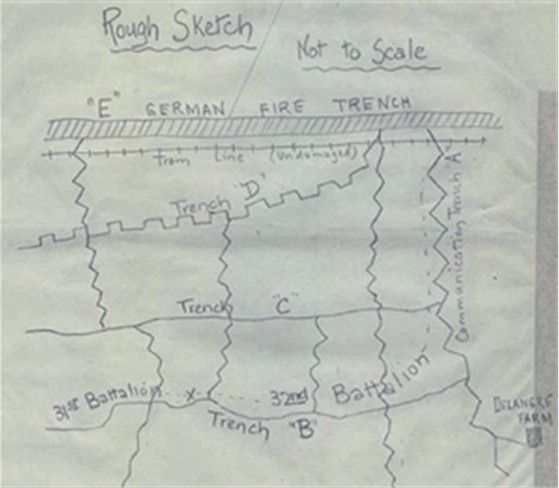
On the 17th, they were reconnoitring the trenches and cutting passages through the wires, preparing for their attack. D company got a short break in Fleurbaix on the afternoon of the 18th but were back in the trenches by 4.15 pm on the 19th preparing for their attack. They were in position by 5.45 and the charges over the parapet began at 5.53 pm.
John’s Company was assigned to the third and fourth waves of the attack.
The 32nd was successful in the initial assaults and by 6.30 pm they were in control of the German’s 1st line system, which was noted in the unit’s war diaries as “practically a ditch with from 1 to 2 feet of mud and slush at the bottom”. However, by 8.30 pm their left flank was under heavy bombardment with high explosives and shrapnel. Return bombardment support was provided and the troops were told that “the trenches were to be held at all costs”.
Fighting continued through the night. At 4 am, the Germans began their attack from the Australian’s left flank and then on the front.
A charge at the Germans’ firing line was made by the Australians, but they were low on grenades and there was machine gun fire from behind from an emplacement at Delangre Farm. They were also so far advanced that they were getting shelled by both sides.
By 7.30 am on the 20th, what was left of the 32nd had withdrawn and John was not among them. The toll on the 32nd was terrible – 718 casualties, 90% of their effective strength.
Fellow West Australian, Lieutenant Sam Mills was wounded but survived the battle. In further letters home, he recalls the bravery of the men of D Company:
“They came over the parapet like racehorses. However, a man could ask nothing better, if he had to go, than to go in a charge like that, and they certainly did their job like heroes."
Room for Optimism? A Long Wait for the Family
With the chaos of the battle, the huge death toll and the post-battle stand-off between the Germans and the Australians across No Man’s Land, it is not difficult to appreciate the uncertainty of the fate of the many soldiers that were unaccounted for.
Soon after the battle, the family were formally advised that John was “missing in action”. However, details provided to them were obviously scarce, even as to where he was missing, as his sister’s letter to the Army asked if it was in Ypres.
John – known to his comrades as Jack, Johnny or John - was in the thick of the advances, bravely leading his platoon. Major Arthur R. White gave evidence that Jack “was with me all through the night of that dreadful battle of July 19 and 20, and he proved a tower of strength.”
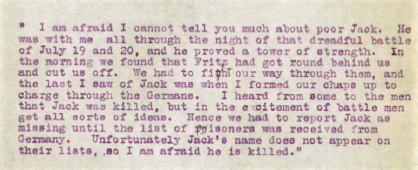
Others also testified to his fate and his qualities as a soldier
- “He was very popular indeed. Gave every man a fair deal. Easily the best Sgt. in the Bttn.” (Sergeant James H. Strickland 1202)
- “Sergeant Walker had done great work that night and continually rallied the men and cheered them up.” (Private Francis A. Downing 921)
- “I found him lying severely wounded with one leg off close to the German third line about midnight 19/20th July. He was unconscious. I pulled him into a shell hole and I had to go on. I heard no more of him.” (Sergeant Alex Scott, 1187 - John was 1186)
Source: AWM Australian Red Cross Wounded and Missing Files – WALKER, John, pages 14, 9 and 12
While most of the reports from soldiers confirmed John’s demise, a few others offered some hope.
Corporal James Morgan, 1323, and Sergeant Alex Scott, 1187, reported that they had been surrounded by Germans. Sergeant Scott went on, “We had orders to retire and he was left there, the enemy very quickly occupying this part of the ground. Many other wounded were lying near Walker and I noticed in the "Times" a few days later the names of some of those wounded and now prisoner of war in Germany ...” This testimony gave rise to hope that John too might be a prisoner of war.
In October 1916, John’s mother received a postcard from one of John’s pals, Private Jack Hetherington, 1286, who advised John was being treated for his wounds in England. This was likely to have been a case of mistaken identity but it needed to be investigated.
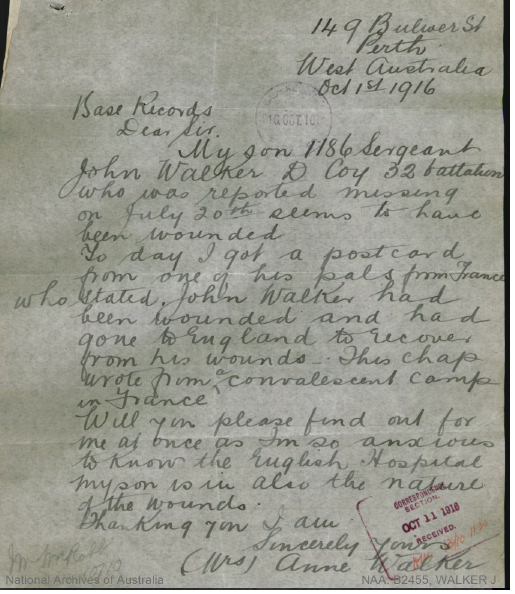
For more than a year, there were numerous enquiries by John’s mother (Anne), his sister Mary, his brother Rodney and even from a lady named Grace - a girlfriend perhaps - all of which were unfortunately answered with “no further details are available”. One of Mary’s letters described the impact of the uncertainty and lack of news as to her brother’s fate on her mother as follows:
“My aged mother is in such a dreadful state that we would almost do anything to relieve her anxiety. I think she would be reconciled if she were absolutely sure he had passed away.”
By the time of Court of Inquiry was held on 12 August 1917, the cable sent from General Moore to the family was unequivocal – “no hope”. A finding was finally made that Sergeant John Walker had been killed in action on 20 Jul 1916 – a day after his 32nd birthday.
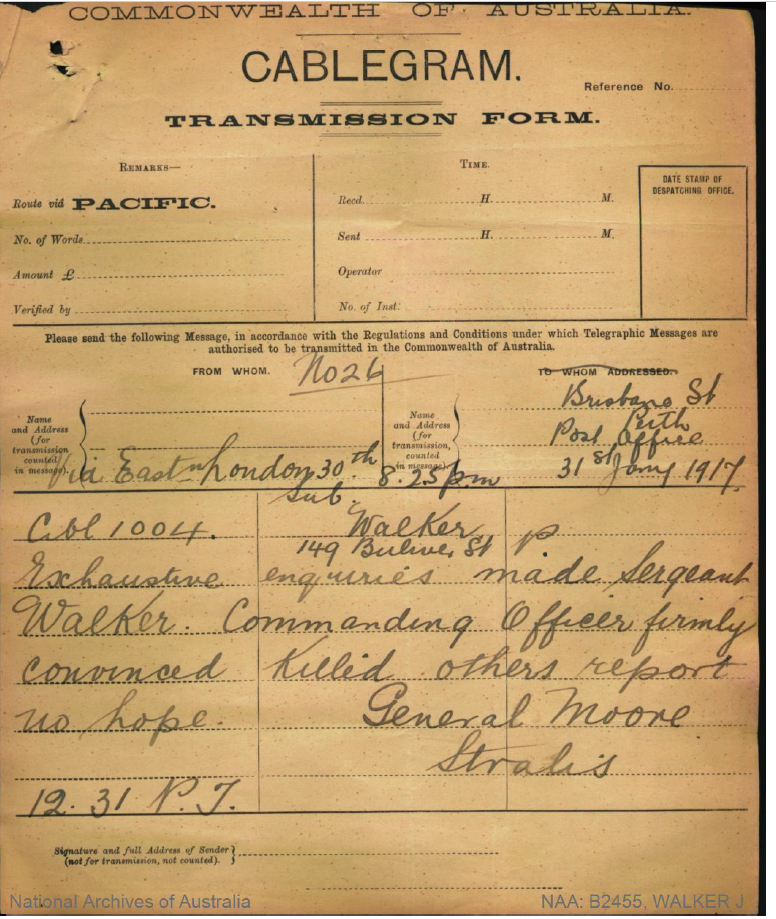
With the Court of Inquiry results confirming his death, John’s medals - the 1914-15 Star, British War Medal, Victory Medal and a Memorial Scroll and a Memorial Plaque - were able to be provided to the family. His medals were eventually issued to his sister, Mary, as both their parents had died within months of each other in late 1918. John’s service was also appreciated by those at home with a commemorative gift presented to Mary in late 1917 in honour of John’s service and sacrifice.
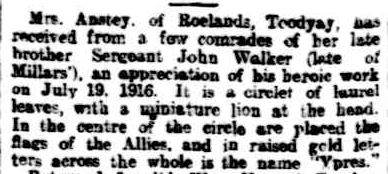
John’s brother, Rodney (service number 7332) also served, joining in November 1916 at the age of 37. His primary duties were with the 1st Australian Convalescent Depot in France. He returned to Australia in December 1919.
A Chance for Final Closure?
John’s final burial place is unknown but he is commemorated at V.C. Corner Australian Cemetery and Memorial, Fromelles, France Panel number 4 and the Roll of Honour, Australian War Memorial, Panel number 121.
In 2008, a mass grave was discovered that had been dug by the Germans to bury soldiers from the battle.
While there have been efforts by the Australian Defence Force and the Fromelles Association of Australia to identify many of the previously unidentified missing solders by DNA testing so that they may be given a proper burial and recognition, John is not among those identified as of this time.
KNOWN UNTO GOD
DNA is still being sought for family connections to
| Soldier | John Michael Bowen WALKER 1884-1916 |
| Parents | William WALKER b. abt 1834 Glasgow Scotland d. 1918 West. Aus and Anne BOWEN b. abt 1840 Queens Co, Ireland d. 1918 West. Aus. |
| Grandparents | |||
| Paternal | John WALKER and Isabella HETTERICK – both from Scotland | ||
| Maternal | Michael BOWEN and Mary MEARA - both from Ireland |
Seeking DNA Donors

Contacts
(Contact: carla@fromelles.info or geoffrey@fromelles.info).
(Contact: army.uwc@defence.gov.au or phone 1800 019 090).
Donations
If you are able, please contribute to the upkeep of this resource.
(Contact: bill@fromelles.info ).
